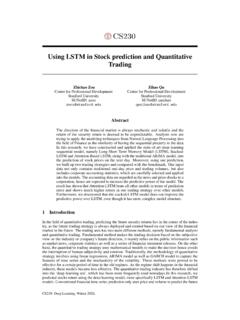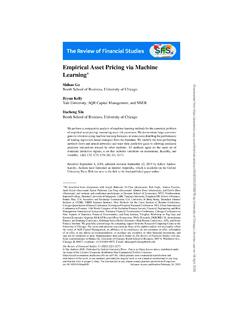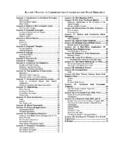Transcription of Stock Market Prediction using CNN and LSTM
1 Stock Market Prediction using CNN and LSTMH amdy HamoudiSUNet ID: hhamoudiStanford A ElseifiSUNet ID: melseifiStanford with a data set of 130 anonymous intra-day Market features and tradereturns, the goal of this project is to develop 1-Dimensional CNN and LSTM Prediction models for high-frequency automated algorithmic trading. Two noveltiesare introduced, first, rather than trying to predict the exact value of the return fora given trading opportunity, the problem is framed as a binary classification withthe positive class selected as the trades resulting in returns in the top ten percentileof all returns in the training set. Furthermore, the 130 anonymous features areaugmented with a logical matrix to reflect the missing data values at each timestep, thus preserving any relevant information from the fact that a given featureis missing from a given record. The models are compared using both machinelearning accuracy measures and investment risk and return metrics.
2 Two CNN andthree LSTM candidate models differing in architecture and number of hidden unitsare compared using rolling cross-validation. Out-of-sample test results are reportedshowing high average return per trade and low overall IntroductionAccurate Prediction of Stock Market returns is a challenging task due to the volatile and nonlinearnature of those returns. Investment returns depend on many factors including political conditions,local and global economic conditions, company specific performance and many other, which makes italmost impossible to account for all relevant factors when making trading decisions [1], [2]. Recently,the interest in applying Artificial Intelligence in making trading decisions has been growing rapidlywith numerous research papers published each year addressing this topic. A main reason for thisgrowing interest is the success of deep learning in applications ranging from speech recognitionto image classification and natural language processing.
3 Considering the complexity of financialtime series, combining deep learning with financial Market Prediction is regarded as one of the mostexciting topics of research [3].The input to our algorithm is a trade opportunity defined by 130 anonymous features representingdifferent Market parameters along with the realized profit or loss on the trade in percentage than using regression models to predict the percent return on a given trade opportunity, wedecided instead to frame the problem as a binary classification one. First a target column is addedto the training data with the trades in the top 10 percentile of all trades in terms of percent returnmarked as the positive class, while the remaining trades are marked as negative (either losers or smallwinners). Rather than trading every opportunity identified as a probable winning trade, the modelswill mostly stay in cash and only trade the few opportunities where the return is predicted to be inthe top percentile.
4 This approach is consistent with studies of historical returns on the S&P500 andother Market indices showing that the best 10 days in any given year are responsible for generatingon average 50% of the total Market return for that year. Furthermore, the best 50 days in any givenCS230: Deep learning , Winter 2018, Stanford University, CA. (LateX template borrowed from NIPS 2017.)year are responsible for about 93% of the total return for the whole year [4] thus the idea of focusingon identifying the most profitable trading opportunity and avoiding taking unnecessary risk by actingon every possible trade signal. The threshold for identifying positive trades is a hyperparameterthat greatly impacts the number of trades executed during the test period (which in turns affects thetrading costs), the total return and the maximum draw-down. Due to resource and time limits, thishyperparameter will not be changed in this study and is left constant at top 10 Related workStock Market Prediction is usually considered as one of the most challenging issues among timeseries predictions [5] due to the noise and high volatility associated with the data.
5 During the pastdecades, machine learning models, such as Artificial Neural Networks (ANNs) [6] and SupportVector Machines (SVR) [7], have been widely used to predict financial time series with remarkableaccuracy. More recently, deep learning models have been applied to this problem due to their abilityto model complex nonlinear topology. An improvement over traditional machine learning models,deep learning can successfully model complex real-world data by extracting robust features thatcapture the relevant information [8] and as a result achieve better performance [9].Many examples for the successful use of deep learning methods in developing algorithmic tradingmodels are available and can generally be split into two categories: Deep learning based methodsand reinforcement learning based methods. For instance, Arevalo et al. [10] introduced a highfrequency trading strategy based on a Deep NN that achieved a 66% directional Prediction and 81%successful trades over the test period.
6 Bao et al. [11] used wavelet transforms to remove the noisefrom Stock price series before feeding them to a stack of autoencoders and a long short-term memory(LSTM) NN layer to make one-day price predictions. Furthermore, M et al. [12] compared CNN toRNN for the Prediction of Stock prices of companies in the IT and pharmaceutical sectors. In theirtest, the Convolutional Neural Network showed better results than the Recurrent Neural Networkand Long-Short Term Memory. The difference in performance was attributed to the fact that CNNdoes not rely on historical data as is the case with time sequence based models. On the other hand,Sutskever et al. [13] argues for the use of LSTM and sequence-to-sequence models for their abilityto retain information from earlier examples in the training set while adapting to newly arrivingdata. Alternatively, many researchers focused on using Reinforcement learning techniques foraddressing the algorithmic trading problem.
7 For instance, Moody and Saell [14] introduced a recurrentreinforcement learning algorithm for identifying profitable investment policies without the need tobuild forecasting models, and Dempster and Leemans [15] used adaptive Reinforcement Learningto trade in foreign exchange markets. Reinforcement learning models present two advantages overDeep learning predictive models. First, RL does not need a large labeled training data set, This is asignificant advantage as more and more data becomes available it becomes very time consuming tolabel the data set. Furthermore, RL models use a reward function to maximize future rewards (rewardfunctions can be formulated according to any optimization objective of interest such as maximumreturn or minimum risk), in contrast to DL regression and classification models which focus onpredicting the probability of future outcomes. We believe that a combination of both methods in aDeep Reinforcement learning approach presents the best of both worlds as it allows the agents tolearn deep features from the training data while avoiding the need for a labeled data set and allowingfor the customization of specific reward Dataset and FeaturesThis study is based on a financial dataset extracted from the Jane Street Market Prediction competitionon Kaggle [16].
8 The available dataset is composed of 2,390,491 record each defined using 130anonymous features measured sequentially spanning 500 days at different time steps during each number of transactions varies from day to day with the minimum being 29 transactions on day294 and the maximum of 18884 transactions on day 44. The data does not specify an explicit targetbut provides five columns that represent the realized percent return on each trade and the returns over4 different time horizons. The objective is to populate an action column with one of two decisions:to trade or not to trade. Note that the exact nature of the trade is unknown (long or short) as wellas the specific instrument or Market traded, in other words, only the return values are provided forthe output. For this study, return values in the top ten percentile of all returns will be marked with2a positive trade signal while every other trade will be marked with a negative signal.
9 Furthermore,by analyzing the missing values from each feature, it is clear that they follow a fixed time patternregardless of the number of transactions on any given day which could be valuable information to thenetwork. As a result, we will augment the features matrix with a logical matrix of size [m,130] wherem is the number of training examples. Each element of the logical matrix at [i,j] will be set to true ifthe features matrix has a missing value at the corresponding [i,j] location. Following the creation ofthe logical matrix, the last 50,000 records of the available data are set aside for to the sequential nature of the dataset, random validation and testing sets are not appropriateand instead we will use a rolling cross-validation approach. We start training with the first 1,000,000transactions and validate on the next 250,000 records. Next, the first validation set is included in thesecond training set resulting in a second training set of 1,250,000 records and we use the following250,000 records for the second and so on until we reach a training set that includes thefirst 2,000,000 records and is validated on the following 250,000 records.
10 The rolling cross-validationprocess is show in schematically in Figure (1) below [20].Prepossessing of the training and development data is performed over two steps. First, a SimpleIm-puter from the SKLearn library [17] is used to replace the missing values with the median of eachfeature over the training set. Next, a RobustScaler from the SKLearn library [18] is used to normalizethe data. This scalar removes the median and scales the data according to the inter-quantile range ofeach feature. The two pre-processors are saved in separate files for use with the test types of models are tested for this project. Three LSTM and two CNN models differing inarchitecture and/or number of hidden layers are considered. using the rolling validation proceduredescribed previously the best model from each family is identified and used for final - CNN Models: A convolutional neural network is a type of deep neural networks that is effectivein forecasting in time series applications.







